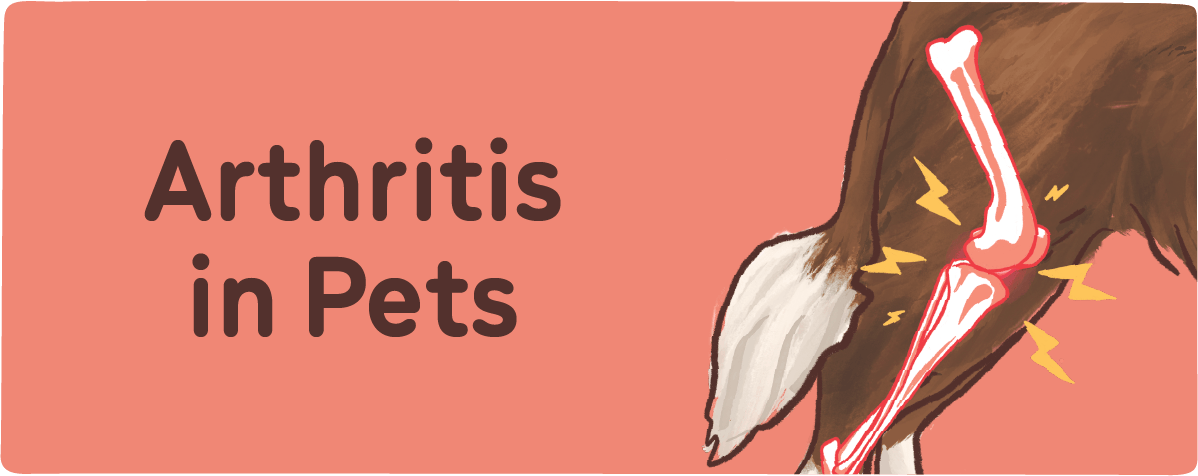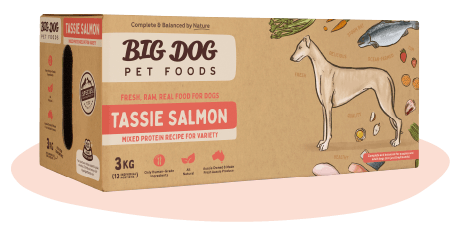Arthritis in Dogs: Prevention and Management

from Integrative Vet, Dr Nicole Rous

Arthritis is a joint condition that involves destruction of the joint lining (cartilage) allowing exposure of the underlying bone. This results in significant pain and reduced mobility – ask any human that suffers from it! Arthritis is common in dogs– reports of 20% - 35% prevalence in adult dogs and 80% in geriatric dogs (>8yrs).
Early signs of arthritis in pets
It’s important to share the early signs of arthritis as they’re commonly missed by owners and perceived as ‘normal.’ The reason I believe owners do this is they’re expecting dogs (and cats, although they show it even less!), to demonstrate pain in a similar way to us. Our pets are just not genetically or evolutionarily wired to do this. It’s far more subtle.
What are the early or subtle signs of declined joint health in dogs? If all pet owners tracked these four factors, especially once their dogs turned 8, it would be so helpful for vets!

1. Stiffness when getting up or taking time to ‘warm up.’
This is a really common sign and although it doesn’t always mean they need to start taking serious pharmaceutical drugs on a daily basis, it does mean action needs to be taken.

2. Reluctance to jump in or out of the car, couch or go up/down stairs.
Whilst many pet owners will comment on this, they don’t realise it is significant.

3. Sleeping a lot.
Although this can be related to ageing, it should be very subtle and slow and not a new or recent finding.

4. A stiffer gait or ‘walk.’
This is one of the most obvious ones for me as I can see it when they walk in the consult door but as owners are with them daily, there’s often minimal daily or weekly change so it can be easily missed. Taking a video monthly of your dog walking once they are over the age of 8 can be a great way to monitor this.
What can we do to help our pets with arthritis?
Preventative health is much easier than reactive health. I prefer to take a proactive step for prevention and management of the early stages of arthritis.
Weight control.

WITHOUT any shadow of a doubt with all the wonderful supplements, drugs, surgeries, integrative therapies, the best thing you can do for your pets is weight control. Obesity is a terrible comorbidity for pets to deal with and accelerates arthritis. Learn how to body condition score your pet and make sure they sit at a healthy weight. The easiest rule of thumb is that you should be able to run your hand along their chest and feel their ribs without pushing your hand in. In Australia around 1/3 of dogs are overweight and just under 10% are obese. You can check out this Healthy Weight Guide for more advice.
Diet quality.

When feeding your pet to manage the early signs of arthritis it’s important to feed them a diet that doesn’t encourage inflammation as arthritis is an inflammatory condition. This means a diet with little to no carbohydrates or sugars, and little to no processing of the original food source. The body must produce a lot of insulin when there’s a big intake of carbohydrates (which are metabolised to glucose and drawn into the bloodstream). Insulin responds to the raised glucose levels and shuttles glucose out of the bloodstream into muscle and fat cells (for later use as an energy source) and this also results in an inflammatory response as well. Check out these Big Dog Pet Foods raw dog food.
Supplements.

The supplement market is a big one, especially in the arthritis space! A word of warning to pet parents is that they need to be able to cut through the marketing to understand what is effective and what just sounds good. Companies don’t need to do a trial or study to register products or sell them and make therapeutic claims, all they need to do is show that the supplement contains an active ingredient that has some scientific evidence behind it. The problem for the consumer is even if they do contain that active ingredient, quality and quantity is everything. Some of my favourite actives that I believe have good scientific evidence.
- Green-lipped mussels. GLM have glucosamine/chondroitin, omega and antioxidant/anti-inflammatory properties and have become popular of late with two brands commonly available at veterinary clinics.
- Curcumin – the active ingredient in Turmeric. When given at the correct quantity and strength curcumin has the ability to help block inflammation which can assist with pain management and decelerate the arthritis process.
- Omega 3’s. At the correct dose, omega 3’s have the ability to reduce the inflammatory response that occurs with arthritis. They must be stored correctly as they can go rancid.
- Glucosamine/Chondroitin Sulphate. This is the supplement that has been around for a LONG time! Suggested to repair damaged cartilage, there is varying evidence to its efficacy but likely best utilised prior to significant arthritis development.
Biomechanic, body work and rehabilitation.

If you had arthritis you would work on fitness and likely see a physiotherapist or osteopath. Well, your dog responds to these therapies in the same way! There are registered vets that have undergone biomechanic training and use techniques of acupuncture, laser therapy, osteopathy and chiropractic to make a huge difference to arthritic pets. This should be considered in the early stages of arthritis (as well as progressed cases. They truly are the magicians of our profession.
Natural drugs.

Integrative vets use the pharmaceutical drugs sparingly and will lean into natural alternatives. The most common utilised are Chinese herbs as well as natural drugs that target the endocannabinoid system – palmitoylethanolamide and medical cannabis (CBD oil).
The benefit of the natural drugs are that they don’t utilise the kidneys for metabolism so can be used in very frail patients and the negative is that there are little published studies on their efficacy and the majority of the evidence is anecdotal.
Arthritis injection.

Many pet parents that have had a dog or cat with arthritis would have been to visit their vet for cartrophen injections. They can be referred to as zydax, pentosan or synovan injections too. They have been around for a long time and despite their routine use (I use it daily, as do most vets), they don't have a lot of solid scientific evidence. Most of the studies were done in petri dishes and not in real dogs but it does seem to be a huge benefit to so many pets. They work by stimulating joint fluid, reducing cartilage breakdown and improving circulation in joints.
There are also newer injectable drugs available now that are administered monthly to specifically target the pain pathway (Beransa). They have been available overseas for a long time, however, have only entered the Australian market since March 2023.
Injectable drugs are popular as owners don’t need to have to worry about getting pills or powders into their dogs but can be more costly as veterinary visits are required. They’re likely safe but there are no long term studies (years long) in dogs to prove their safety and we rely on anecdotal evidence for this.
Pharmaceutical drugs.

Anti-inflammatory and pain relief drugs may be used early in the process of arthritis if an injury caused the joint damage (think cruciate damage) or if the veterinarian is assessing the degree of pain. They’re amazing drugs and even as an integrative vet I utilise them a lot! The most common drugs we use are non-steroidal anti-inflammatory drugs. They do require adequate kidney function in order to metabolise them so if they’re to be used long-term blood work will be required to make sure the body is coping with them. Other drugs that are also often target nerve pain (e.g. Gabapentin) or the general pain response (paracetamol). That’s right, our mainstay in the human world, paracetamol is safe when used at the correct dose.
The downside to the use of pharmaceutical drugs is often the cost involved, veterinary intervention required (as they need prescriptions) and that they require adequate liver and kidney function to support their use. They also can have side effects such as vomiting or diarrhoea.
Big Dog’s Recipe Recommendations for healthy joints:

![Big Dog Pet Foods - Sensitive Skin [Scientific Range]](https://cdn.prod.website-files.com/689afa9f5c9eb1df71679f2a/689afa9f5c9eb1df7167a2df_6666f26b2315fc836c05f155_64ab497f06170770086af4d5_sensitive%252520skin.png)
![Big Dog Pet Foods - Wellbeing [Scientific Range]](https://cdn.prod.website-files.com/689afa9f5c9eb1df71679f2a/689afa9f5c9eb1df7167a2e2_6666f26b2315fc836c05f15e_64ab499e24feeaa9a67e69b6_wellbeing.png)
Tasmanian Salmon provides great nutrition for dogs of all ages. This recipe is high in omegas and anti-inflammatories.
Sensitive Skin is a recipe of premium nutrition to include for all dogs, particularly those susceptible to joint issues for its omegas, anti-inflammatories and supportive herbal blend.
Wellbeing provides supportive nutrition as this recipe is high in omegas and anti-inflammatories, it’s also low in fat for dogs that are less active and/or need to lose weight to reduce the pressure on their joints.

Nourish Nutrition Joint+ Support is scientifically formulated to assist with bone and joint health in dogs.

About the Author - Dr. Nicole Rous
Dr. Nicole Rous completed her degree with Honours from the University of Sydney in 2008. She initially worked in the UK before returning to small animal practice in Melbourne, Australia. Dr. Nicole has a keen interest in animal reproduction and has been granted Membership with the Australian and New Zealand College of Veterinary Scientists in this specialty. She is also passionate about complementary therapies such as massage and enjoys discussing ways to enhance pets' overall well-being and quality of life.
In August 2021, Dr. Nicole joined the Mont Albert Veterinary Surgery team as a director and continues to provide exceptional care to her patients. She is dedicated to utilising her knowledge and experience to assist pets in living longer, healthier, and happier lives.
Dr. Nicole's commitment to providing natural and holistic health practices for pets inspired her to establish Shy Tiger, a company that offers natural pet products made from premium ingredients sourced primarily from Australian farms and producers. Her expertise in natural health practices and dedication to providing excellent care to her patients make her a reliable partner for pet owners in Melbourne and beyond.
